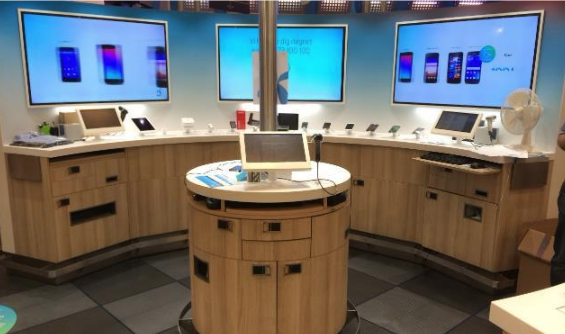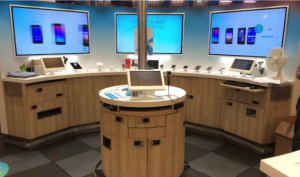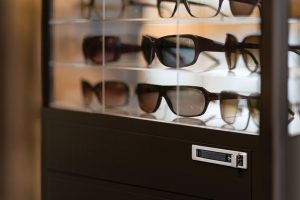–Sponsored Content–
The shopper experience requires two elements to make a sale. First, consumers need to be captivated by the product. But second, for that to happen, they need to pick it up, interact with it and fall under its spell. The question is though, when you’re talking about a piece of fine jewelry, or let’s say a Birkin bag, how do you insure that precious commodities like these won’t leave the store — account unpaid?
The stats tell the story. According to the National Retail Survey, shrinkage in 2016 alone accounted for nearly $50 billion in losses. The four main sources for this are shoplifting and employee theft, while paperwork errors and vendor fraud account for smaller percentages.
Welcome to the new world of digital locks.
When it comes to protecting your inventory, necessity is the mother – not just of invention – but prevention. Retail is experiencing a 2.0 moment — forcing the industry to become more creative in the ways it displays its wares while discouraging theft.
Retailers know that when they pull together all the items that make up an outfit, the sales for each goes up. For example, when you put a dress on a mannequin and pair it with shoes, a belt, a jacket and jewelry, each of those categories will experience higher sales. But then comes the problem of protecting against loss.
Suzanne Lee, Marketing Manager from Digilock, a leading innovator of locking systems for retail, both front and back of store comments. “One of our retail customers secures fine jewelry with an RFID wired locking system on their case goods displays. They also utilize mailbox lockers to store customer paperwork and products that are to be picked up at a later date. However, the restrictive manner of the wired system imposed some limitations on how products could be displayed in a secure, but accessible fashion. For this customer, we installed electronic keypad cam locks, which integrated into their existing security systems and added much needed functionality. For luxury goods retailers like Cartier and Rolex, the cost of doing business is high. They occupy expensive real estate and they have a lot to lose, so the challenge to make merchandise enticing and safe requires a smart strategy around security.”
Retail is popping up everywhere.
Pop-up stores are hot, accounting for over $10 billion in revenue in 2017 alone. This innovation in retail creates challenges for security. When pop-ups appear, supported by social media and all manner of enticing deals and limited merchandise, they can create a flash-mob phenomenon. How to secure merchandise when 2,000 people show up? Savvy retailers use a “Zone Defense” much like pro-football. Employees are assigned to specific zones where customers have contact with merchandise. They act as sales associates while monitoring activities. Further, digital locks secure products unobtrusively.
Pop-ups also share a security risk common to all retailers … the challenge of employee turnover and its impact on shrinkage.
Turnover in retail is an expensive reality.
When employees leave, pass cards and keys can be easily lost or forgotten. Rekeying locks is a huge security cost for retailers, and store managers need solutions to drive these costs down. Digital locks actually eliminate the need for rekeying.
Another popular solution in retail is RFID technology. One of Digilock’s European clients uses RFID in securing retail environments. This telecommunications company has retail stores throughout Scandinavia, Central Eastern Europe and Asia. They experience a constant flow of customers, and need to manage valuables, documents and inventory while reducing internal and external shrinkage. With the addition of RFID locks, sales associates can quickly access any locked cabinet or drawer with the use of assigned credentials. This offers a durable solution that can withstand the high stress and constant use of locks in their retail stores. It has increased productivity and sales.
How to unite merchandising, store operations and loss prevention.
According to Digilock’s Suzanne Lee, “We advise our clients to be proactive and create a culture of loss prevention. This includes everything from ‘Zones of Influence’ to RFID technology to providing safe locked-spaces for employees, showing you care about their security. More effective security practices on the job are often the result.”
This edition of VMSD's Retail Voice thought leadership series is sponsored by Digilock. To learn more about digital lock solutions visit digilock.com.
Biographies:
Stephanie Becker, Digilock’s Product Marketing Associate, collaborates with the Sales and Product Management Departments to ensure strategic alignment for marketing at the product level. With a passion for product and a strong interest in developing creative marketing strategies, she supports the execution of advertising, tradeshows, and digital marketing programs. Stephanie possesses a Bachelor of Arts in Communication from University of California, Santa Barbara, and enjoys applying theories and practices from classes to projects in the workplace.
Suzanne Lee is a Product Manager who works with engineers and executives to bring strong, competitive products to market through data-driven research and a little out-of-the-box thinking. Suzanne believes in encouraging creativity, building lasting relationships, and working outside of your comfort zone. Suzanne's previous roles at Digilock includes business development and managing the marketing department. Suzanne holds a Masters in Communications and Information Studies from Rutgers University.


 Photo Gallery2 weeks ago
Photo Gallery2 weeks ago
 Headlines5 days ago
Headlines5 days ago
 Headlines1 week ago
Headlines1 week ago
 Headlines2 weeks ago
Headlines2 weeks ago
 Headlines2 weeks ago
Headlines2 weeks ago
 Headlines4 days ago
Headlines4 days ago
 Headlines3 days ago
Headlines3 days ago
 Designer Dozen1 week ago
Designer Dozen1 week ago
















